Some artists might say that art is never finished, merely abandoned. Sometimes, however, artists truly fail to complete their paintings for many reasons. Sometimes outside events intervene, other times, they lose inspiration and creativity. In some instances, they may choose to leave their work unfinished to make a statement. Whatever the case might be. Unfinished artworks hold a certain allure, and to the art aficionados, the greatest unfinished works are evocative of what could have been. Below, we have listed 10 of our favorite unfinished artworks.
10) The Adoration of the Magi / Leonardo Da Vinci
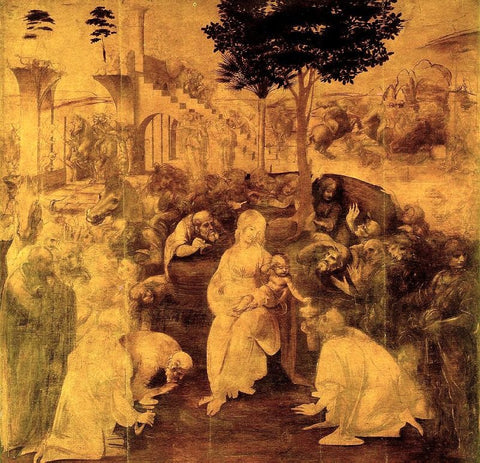
A document from July 1481 states that Leonardo Da Vinci had received a commission from the Augustinian monks to paint a panel for the high altar in the church of San Donato in Scopeto, outside Florence city walls. Leonard Da Vinci was the embodiment of the statement “Quality Takes Time” so he undertook to finish the “The Adoration of the Magi” within 30 months. He was notoriously slow to finish any work because his vast array of talents such as engineering, science, and mathematics kept on sidetracking him.
Initially, Da Vinci created a life-size draft which was over 2.1 meters (7 ft) squared and portrayed the under-paint tones. However, in 1942, Da Vinci left Florence for the court of Ludovico Sforza in Milan, interrupting the painting he was producing for the church of San Donato. The Augustinian friars waited in vain for the artist to return and complete his painting, until they decided to commission another altar piece with the Adoration of the Magi from Filippino Lippi, which was completed in 1496. Both versions still stand today at Uffizi Gallery in Florence.
9) Treaty Of Paris / Benjamin West
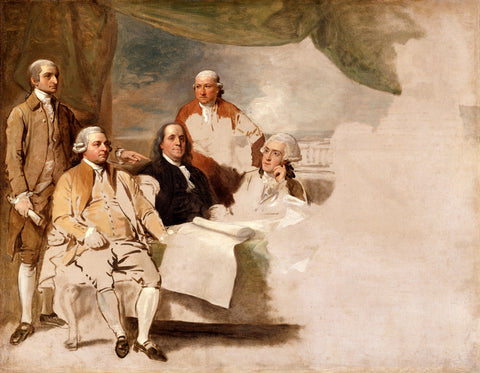
On November 30th, 1783 the American and British delegations of peace commissioners met in Paris to sign a treaty that ended the Revolutionary War. Benjamin Franklin and John Adams were among the American delegates. In accordance to American law and tradition, what had once been the American colonies ceased to be so on July 4th, 1776, but the British did not formally recognize the separation until the Treaty of Paris went into effect. To say that the British were somewhat uncomfortable with the whole idea-and embarrassed that they lost the war is an understatement.
To celebrate the Treaty of Paris famed historical artist Benjamin West, a Pennsylvania-born painter who moved to England just before the Revolution was commissioned to memorialize the treaty signing. Benjamin West tried his best, but the British delegation refused to be painted as they felt the defeat was shameful. As a result, the painting has a gaping blank space where they would have been.
Adams and Franklin got a big kick out of the British delegate’s refusal to sit for the portrait. In fact, when he returned to the United States, John Adams took the picture home with him and hung it on his wall. It is believed that the painting once hung in the White House during Adam’s presidency.
8) Victory Boogie Woogie / Piet Mondrian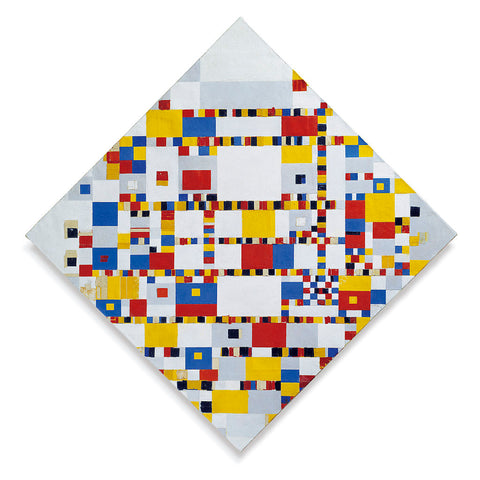
Dutch artist Piet Mondrian’s abstract works are known throughout the world for the way that they convey city layouts in the most basic elemental colors and shapes.
Reflecting the musical influences and energy of New York, Victory Boogie Woogie was never finished due to Mondrian’s unfortunate death from pneumonia in 1944. Looking closely at the picture, we can see that the bolder, simpler lines have been replaced with smaller, more vibrant squares of sticky tape as the painting developed. Alongside the musical influences, the name Victory Boogie Woogie also represents Mondrian’s enthusiasm and belief that the US and the Allies would help win World War II.
Housed at the Gemeentemuseum in the Netherlands, the sale of the painting for $40 million in 1998 caused controversy when it transpired that the money had been donated by the Dutch Central Bank, raising questions about whether it was truly worth $40 million.
7) James Hunter, Black Draftee / Alice Neel

American portrait artist Alice Neel’s oil painting James Hunter Black Draftee is a great example of how a painting can be finished yet incomplete. Despite not finishing the work physically, Neel decided that its incomplete nature conveyed the emotions she wanted, so she put her signature on it and displayed it in the Whitney Museum. The story behind why the painting is incomplete is a poignant one.
Unappreciated for most of her career, Neel would often invite strangers to sit for a portrait. In 1965, she invited James Hunter, who had just found out that he had been drafted for service in the Vietnam War. The first sitting captured his melancholy and contemplative look. Neel finished most of his face and outlined the rest of his body.
Hunter never turned up for the second sitting. Mysteriously, his name never appeared on the list of soldiers at the Vietnam Veterans Memorial, so we can assume that unless he used a pseudonym, he didn’t die in Vietnam. However, his whereabouts remain unknown to this day.
6) Madonna With the Long Neck / Parmigianino
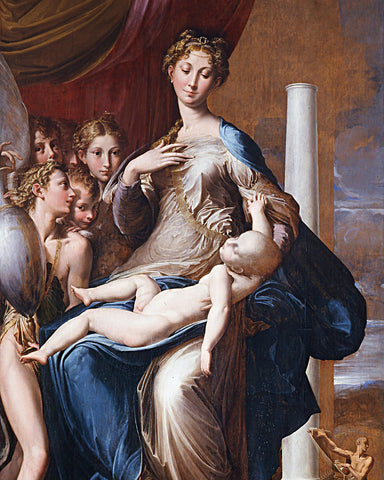
Girolamo Francesco Maria Mazzola (also known as Parmigianino due to his birth in Parma) was an Italian Renaissance painter who painted in the Mannerism style of exaggerated and elongated proportions to suggest beauty and grace. Commissioned to paint a picture of Mary and Jesus for a funeral chapel, Parmigianino spent several years tinkering on Madonna with the Long Neck before dying of a fever in 1540.
A renowned perfectionist, Parmigianino is perhaps a classic example of not knowing when to stop. Despite several drafts and stagings, he never quite achieved what he wanted, and the tampering has led to several noticeably incomplete areas. Not only are the column and sky unfinished, but the figure of Saint Jerome in the bottom right corner has a floating foot next to him.
5) Portrait of George Washington / Gilbert Stuart 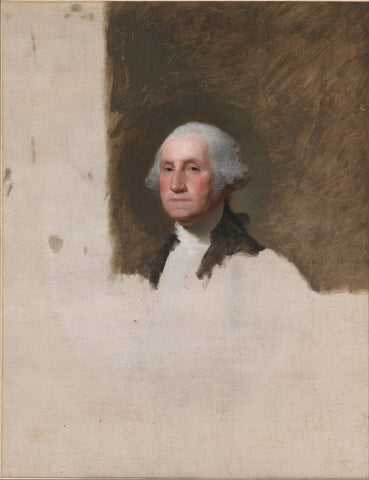
One of the most regarded portrait artists of his day, Gilbert Stuart painted over 1,000 people, including US presidents and kings and queens across Europe. His most famous artwork, however, is a deliberately incomplete painting of George Washington.
After Stuart’s initial painting of George Washington in 1795 was a success, George’s wife Martha asked Stuart to create another picture of him in 1796. Stuart did not finish this second portrait (referred to as the Athenaeum Portrait) and instead stopped after painting the face and part of the background. A shrewd businessman, he used this likeness to replicate dozens of copies that sold for $100 each. It is this image that is used on the $1 bill.
Allegedly, Washington was a difficult person to paint. Stuart initially found it difficult to generate the likeness he wanted due to Washington’s reserved nature. Also, Washington’s new dentures caused his jawline to protrude, distorting his face—not surprising since they were made up of metal, ivory, and cow and human teeth.
4) Oscar Pistorius – The Interrupted Portrait / Natalie Holland
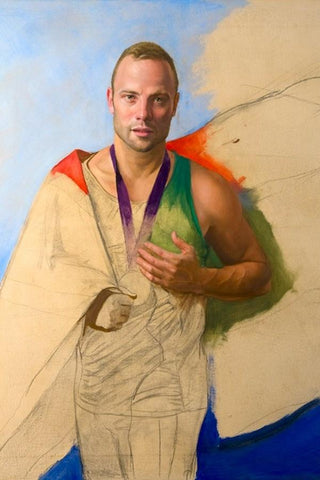
Also known as the “Blade Runner,” Oscar Pistorius was a hero to many, as he defied his disabilities (having been born without a fibula bone in both legs) to win six gold medals at the Paralympics. Such was his dominance compared to the other Paralympians that he even competed in the 400m at the 2012 summer Olympics—the first double-leg amputee to do so.
To celebrate the event, Russian-born artist Natalie Holland was commissioned to paint several portraits of Pistorius. It is the third portrait, the one in which she desired to show him in victory, that remains unfinished.
After Holland had completed his face and arms, news spread that Pistorius had shot and killed his girlfriend, Reeva Steenkamp. Unable to bring herself to complete the picture, it remains frozen in time.
3) The Unfinished Portrait / Elizabeth Shoumatoff
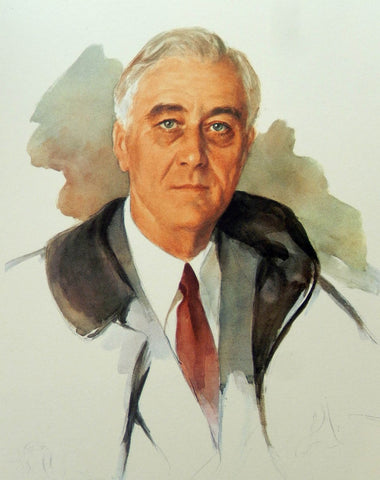
Not happy with her first attempt at painting Franklin Delano Roosevelt in 1943, Elizabeth Shoumatoff came back for another try to capture Roosevelt’s energy and dynamism toward the end of World War II. She had heard that F.D.R. was in ill health, but he insisted on being painted. He was in good spirits during the week the painting was being completed, mimicking Winston Churchill and commenting that he believed Joseph Stalin had poisoned his wife. Unfortunately, while Shoumatoff was painting, Roosevelt complained of a headache and then slumped forward, unconscious. He had suffered a stroke and died later that day. In the room at the time with Shoumatoff was Lucy Mercer Rutherford, F.D.R.’s former mistress, who had arranged the commission.
Shoumatoff did complete a nearly identical replica of Roosevelt. Selling a photograph of the original to the New York Daily News for $25,000, she later donated the incomplete work to the Little White House, F.D.R.’s Georgia retreat where he died.
2) The Entombment / Michelangelo
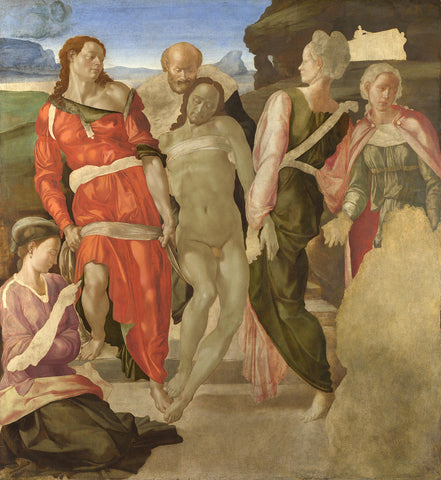
The Entombment is an unfinished piece depicting Jesus’s body being placed inside His tomb after the crucifixion. The painting is shrouded in mystery. There is no signature on the piece, several figures are missing, and the painting itself was lost for centuries. Part of the evidence that suggests this work of Michelangelo’s is that he was commissioned by the Saint Agostino church in Rome to paint a panel for their altar, but later sent back the money he was given. Unfortunately, there is no record of what the church asked him to paint, nor does Michelangelo refer to this painting in any notes.
Why did Michelangelo leave an unfinished piece? It is certain that he left Rome for Florence around the time that the painting was abandoned. One story that has endured is that his friends managed to obtain a large piece of marble from the cathedral in Florence. He was then commissioned by them to create a sculpture—the statue of David.
The Entombment slipped into obscurity until 1846, when Scottish photographer and painter Robert Macpherson was looking through a job lot of paintings intended to be destroyed. The wood from The Entombment was going to be used to make a table until Macpherson bought it for £1. In 1868, he sold it to the National Gallery for £2,000. Next time you come across a pile of discarded paintings about to be thrown out, you never know: There might just be a Michelangelo in there.
1) Turning Road – Paul Cezanne
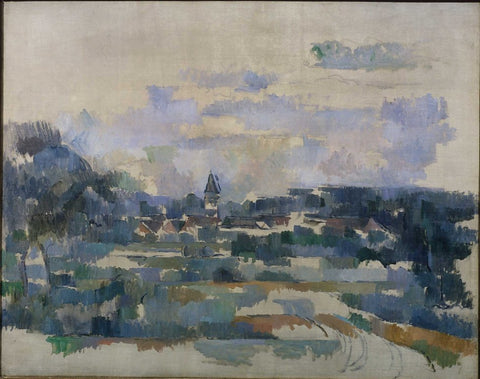
The last artist on this list is Paul Cezanne, a painter whose later works often asked the question, “When is a painting truly finished?” Cezanne feared that a single wrong brushstroke would ruin the whole piece, so much of his work followed a “less is more” impressionist style.
His later pieces such as Turning Road left whole sections of the canvas bare, emphasizing the paint that was left. Some believe that this was unintentional and that his poor eyesight led him to miss parts of the picture. Whatever the reason, finished or unfinished, an artwork’s beauty truly is in the eye of the beholder.
Art Interrupted – Top 10 Fascinating Unfinished Paintings
Some artists might say that art is never finished, merely abandoned. Sometimes, however, artists truly fail to complete their paintings for many reasons. Sometimes outside events intervene, other times, they lose inspiration and creativity. In some instances, they may choose to leave their work unfinished to make a statement. Whatever the case might be. Unfinished artworks hold a certain allure, and to the art aficionados, the greatest unfinished works are evocative of what could have been. Below, we have listed 10 of our favorite unfinished artworks.
10) The Adoration of the Magi / Leonardo Da Vinci
A document from July 1481 states that Leonardo Da Vinci had received a commission from the Augustinian monks to paint a panel for the high altar in the church of San Donato in Scopeto, outside Florence city walls. Leonard Da Vinci was the embodiment of the statement “Quality Takes Time” so he undertook to finish the “The Adoration of the Magi” within 30 months. He was notoriously slow to finish any work because his vast array of talents such as engineering, science, and mathematics kept on sidetracking him.
Initially, Da Vinci created a life-size draft which was over 2.1 meters (7 ft) squared and portrayed the under-paint tones. However, in 1942, Da Vinci left Florence for the court of Ludovico Sforza in Milan, interrupting the painting he was producing for the church of San Donato. The Augustinian friars waited in vain for the artist to return and complete his painting, until they decided to commission another altar piece with the Adoration of the Magi from Filippino Lippi, which was completed in 1496. Both versions still stand today at Uffizi Gallery in Florence.
9) Treaty Of Paris / Benjamin West
On November 30th, 1783 the American and British delegations of peace commissioners met in Paris to sign a treaty that ended the Revolutionary War. Benjamin Franklin and John Adams were among the American delegates. In accordance to American law and tradition, what had once been the American colonies ceased to be so on July 4th, 1776, but the British did not formally recognize the separation until the Treaty of Paris went into effect. To say that the British were somewhat uncomfortable with the whole idea-and embarrassed that they lost the war is an understatement.
To celebrate the Treaty of Paris famed historical artist Benjamin West, a Pennsylvania-born painter who moved to England just before the Revolution was commissioned to memorialize the treaty signing. Benjamin West tried his best, but the British delegation refused to be painted as they felt the defeat was shameful. As a result, the painting has a gaping blank space where they would have been.
Adams and Franklin got a big kick out of the British delegate’s refusal to sit for the portrait. In fact, when he returned to the United States, John Adams took the picture home with him and hung it on his wall. It is believed that the painting once hung in the White House during Adam’s presidency.
8) Victory Boogie Woogie / Piet Mondrian
Dutch artist Piet Mondrian’s abstract works are known throughout the world for the way that they convey city layouts in the most basic elemental colors and shapes.
Reflecting the musical influences and energy of New York, Victory Boogie Woogie was never finished due to Mondrian’s unfortunate death from pneumonia in 1944. Looking closely at the picture, we can see that the bolder, simpler lines have been replaced with smaller, more vibrant squares of sticky tape as the painting developed. Alongside the musical influences, the name Victory Boogie Woogie also represents Mondrian’s enthusiasm and belief that the US and the Allies would help win World War II.
Housed at the Gemeentemuseum in the Netherlands, the sale of the painting for $40 million in 1998 caused controversy when it transpired that the money had been donated by the Dutch Central Bank, raising questions about whether it was truly worth $40 million.
7) James Hunter, Black Draftee / Alice Neel
American portrait artist Alice Neel’s oil painting James Hunter Black Draftee is a great example of how a painting can be finished yet incomplete. Despite not finishing the work physically, Neel decided that its incomplete nature conveyed the emotions she wanted, so she put her signature on it and displayed it in the Whitney Museum. The story behind why the painting is incomplete is a poignant one.
Unappreciated for most of her career, Neel would often invite strangers to sit for a portrait. In 1965, she invited James Hunter, who had just found out that he had been drafted for service in the Vietnam War. The first sitting captured his melancholy and contemplative look. Neel finished most of his face and outlined the rest of his body.
Hunter never turned up for the second sitting. Mysteriously, his name never appeared on the list of soldiers at the Vietnam Veterans Memorial, so we can assume that unless he used a pseudonym, he didn’t die in Vietnam. However, his whereabouts remain unknown to this day.
6) Madonna With the Long Neck / Parmigianino
Girolamo Francesco Maria Mazzola (also known as Parmigianino due to his birth in Parma) was an Italian Renaissance painter who painted in the Mannerism style of exaggerated and elongated proportions to suggest beauty and grace. Commissioned to paint a picture of Mary and Jesus for a funeral chapel, Parmigianino spent several years tinkering on Madonna with the Long Neck before dying of a fever in 1540.
A renowned perfectionist, Parmigianino is perhaps a classic example of not knowing when to stop. Despite several drafts and stagings, he never quite achieved what he wanted, and the tampering has led to several noticeably incomplete areas. Not only are the column and sky unfinished, but the figure of Saint Jerome in the bottom right corner has a floating foot next to him.
5) Portrait of George Washington / Gilbert Stuart
One of the most regarded portrait artists of his day, Gilbert Stuart painted over 1,000 people, including US presidents and kings and queens across Europe. His most famous artwork, however, is a deliberately incomplete painting of George Washington.
After Stuart’s initial painting of George Washington in 1795 was a success, George’s wife Martha asked Stuart to create another picture of him in 1796. Stuart did not finish this second portrait (referred to as the Athenaeum Portrait) and instead stopped after painting the face and part of the background. A shrewd businessman, he used this likeness to replicate dozens of copies that sold for $100 each. It is this image that is used on the $1 bill.
Allegedly, Washington was a difficult person to paint. Stuart initially found it difficult to generate the likeness he wanted due to Washington’s reserved nature. Also, Washington’s new dentures caused his jawline to protrude, distorting his face—not surprising since they were made up of metal, ivory, and cow and human teeth.
4) Oscar Pistorius – The Interrupted Portrait / Natalie Holland
Also known as the “Blade Runner,” Oscar Pistorius was a hero to many, as he defied his disabilities (having been born without a fibula bone in both legs) to win six gold medals at the Paralympics. Such was his dominance compared to the other Paralympians that he even competed in the 400m at the 2012 summer Olympics—the first double-leg amputee to do so.
To celebrate the event, Russian-born artist Natalie Holland was commissioned to paint several portraits of Pistorius. It is the third portrait, the one in which she desired to show him in victory, that remains unfinished.
After Holland had completed his face and arms, news spread that Pistorius had shot and killed his girlfriend, Reeva Steenkamp. Unable to bring herself to complete the picture, it remains frozen in time.
3) The Unfinished Portrait / Elizabeth Shoumatoff
Not happy with her first attempt at painting Franklin Delano Roosevelt in 1943, Elizabeth Shoumatoff came back for another try to capture Roosevelt’s energy and dynamism toward the end of World War II. She had heard that F.D.R. was in ill health, but he insisted on being painted. He was in good spirits during the week the painting was being completed, mimicking Winston Churchill and commenting that he believed Joseph Stalin had poisoned his wife. Unfortunately, while Shoumatoff was painting, Roosevelt complained of a headache and then slumped forward, unconscious. He had suffered a stroke and died later that day. In the room at the time with Shoumatoff was Lucy Mercer Rutherford, F.D.R.’s former mistress, who had arranged the commission.
Shoumatoff did complete a nearly identical replica of Roosevelt. Selling a photograph of the original to the New York Daily News for $25,000, she later donated the incomplete work to the Little White House, F.D.R.’s Georgia retreat where he died.
2) The Entombment / Michelangelo
The Entombment is an unfinished piece depicting Jesus’s body being placed inside His tomb after the crucifixion. The painting is shrouded in mystery. There is no signature on the piece, several figures are missing, and the painting itself was lost for centuries. Part of the evidence that suggests this work of Michelangelo’s is that he was commissioned by the Saint Agostino church in Rome to paint a panel for their altar, but later sent back the money he was given. Unfortunately, there is no record of what the church asked him to paint, nor does Michelangelo refer to this painting in any notes.
Why did Michelangelo leave an unfinished piece? It is certain that he left Rome for Florence around the time that the painting was abandoned. One story that has endured is that his friends managed to obtain a large piece of marble from the cathedral in Florence. He was then commissioned by them to create a sculpture—the statue of David.
The Entombment slipped into obscurity until 1846, when Scottish photographer and painter Robert Macpherson was looking through a job lot of paintings intended to be destroyed. The wood from The Entombment was going to be used to make a table until Macpherson bought it for £1. In 1868, he sold it to the National Gallery for £2,000. Next time you come across a pile of discarded paintings about to be thrown out, you never know: There might just be a Michelangelo in there.
1) Turning Road – Paul Cezanne
The last artist on this list is Paul Cezanne, a painter whose later works often asked the question, “When is a painting truly finished?” Cezanne feared that a single wrong brushstroke would ruin the whole piece, so much of his work followed a “less is more” impressionist style.
His later pieces such as Turning Road left whole sections of the canvas bare, emphasizing the paint that was left. Some believe that this was unintentional and that his poor eyesight led him to miss parts of the picture. Whatever the reason, finished or unfinished, an artwork’s beauty truly is in the eye of the beholder.